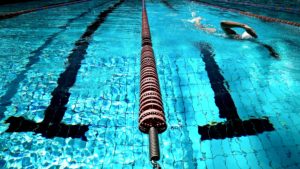Floaties float… until something goes wrong.
And until that something goes wrong, we think our kids are fine floating with them, but sometimes even functional floaties are deadly. You’ve heard the term ‘bubble-wrapping’ as when we try to protect children from the world, usually too much, resulting in them being unprepared for life’s curveballs. When we bubble-wrap our kids in floaties against the dangers of water, we are unintentionally exposing them to the dangers too…
The first thing we need to have in mind is that floating is the very basis of learning how to stay safe in the water and swim – even if you don’t know a stroke, knowing how to hold yourself in the water is crucial. Floaties take away a child’s need to hold themselves and instead gives them a false sense of security, in addition to a dangerous sense of ease for parents. According to swim authorities, floaties are classified as toys, and labels on such will clearly state that they are NOT life-saving devices. As such, using them instead of teaching a child to swim can result in many sticky situations.
Firstly, the aid that floaties provide is detrimental to good swimming practices, such as the position they hold a person in. Arm floaties hold the body vertically, and elevate the arms while giving no support to the head. They may also slide down the arms, holding the lower arms above the water and pushing the head below the water. Tubes, rings or any waist floaties, while freeing the arms, can still hold a child underwater if they manage to flip themselves under and do not have the swimming capabilities to right themselves or wriggle out of the tube. These are also susceptible to popping, instantly disorienting the child, which could result in drowning. Having said this, any serious accidents can be prevented by diligent supervision, but giving a child the skills to deal with mishaps in the water themselves will be extremely wise in the long run.
The other thing to keep in mind with floatation devices is that not all of them are bad – consider whether they are active or passive; a passive device includes arm floaties or tubes, because they do all the work, but an active device, like a pool noodle or kickboard, teach the kid to support at least some of their own weight, as well as balance and core strength in the water. Personal Floatation Devices (PFDs) are another form of device that is acceptable in circumstances, as long as they meet the Australian standard, such as on board boats.
Some resources on the Internet will disagree that floaties are bad, suggesting that they give parents less to worry about and the children more confidence in the water, but ultimately these are dangerous carefree attitudes that are easily broken when they can no longer be supported. There is a level of attention required around water, but there is also a need for balance between surveillance and learning, and this is where we need to peel back the bubble wrap and let children embrace their natural swimming abilities.
If we embrace the idea that floaties are toys and not survival aides it will be a lot easier to keep children’s reliance on them to a minimum whilst still bringing fun to the pool with some buoyancy bliss! Who doesn’t love the feeling of weightlessness, simply in the right environment? Have fun with your kids learning to swim, see it as an opportunity for bonding rather than an entertainment to keep them distracted.
In the end, all children need swimming lessons to achieve maximum survival skills and water safety, and no floatation device replaces diligent watching by an adult who themselves know how to swim, which you can read more about in our next piece, so keep an eye out, both here and around the water!
Written by: Maggie Stuurstraat




